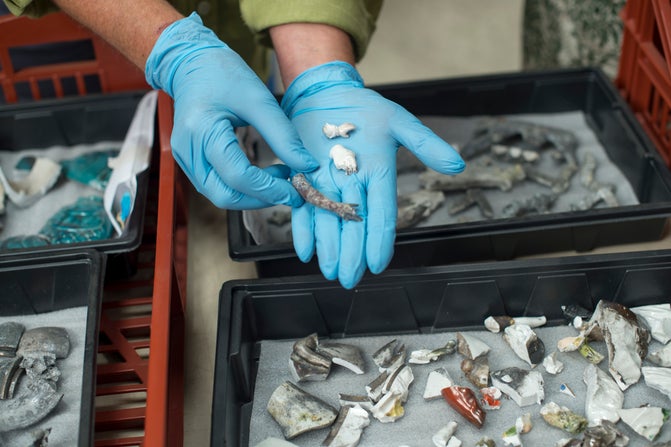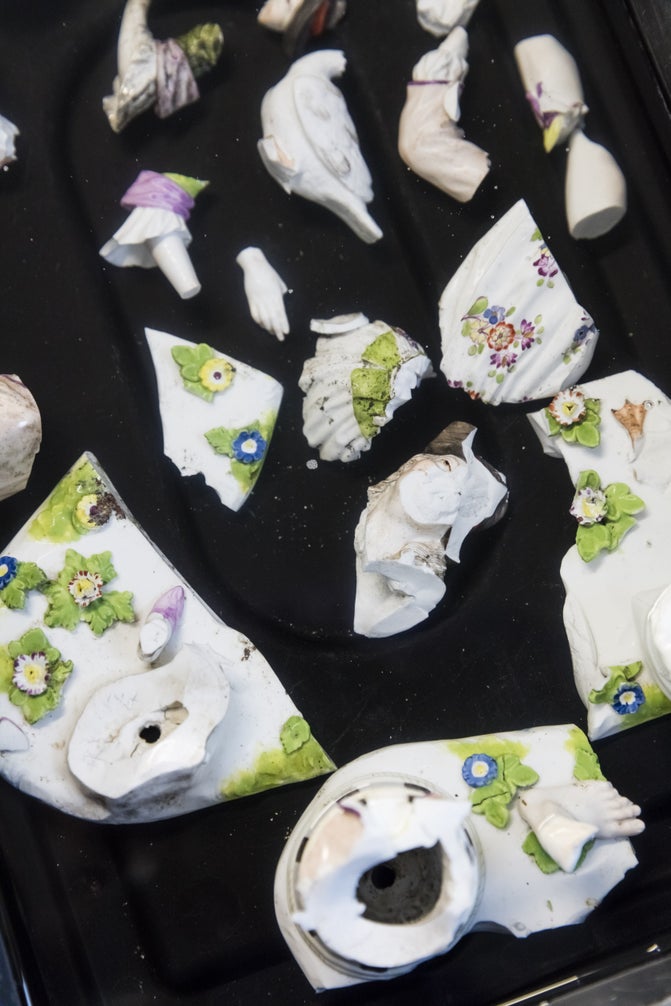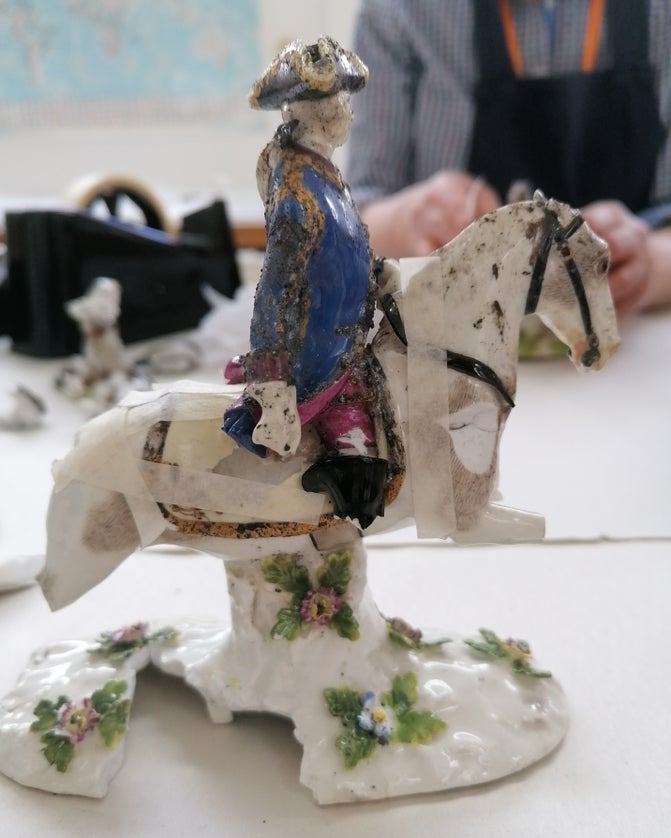Ten years of making at Clandon Park
- Published:
- 29 April 2025
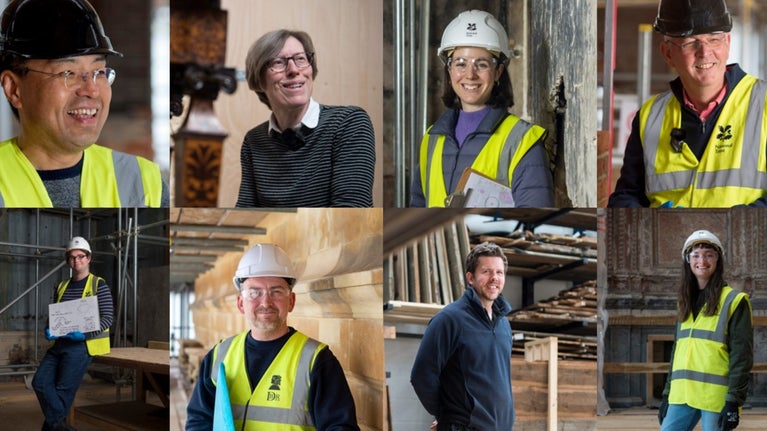
29th April 2025 is the tenth anniversary of the fire that transformed Clandon Park. We’re marking the day by showcasing 10 years of making at Clandon, sharing stories from the people bringing Clandon back to life.
Like many anniversaries, the day is tinged with a sadness still felt for what was lost. We’re marking the day with behind-the-scenes glimpses of what has been revealed by the transformative fire, and a community shaped and linked by a shared purpose to care for Clandon. An expanding community where local neighbours, volunteers, and National Trust staff have been joined by skilled craftspeople and specialists.
Ten people from this community share an insight into the work they have been doing and what Clandon means to them.
Meet Sara, piecing together Clandon's ceramics
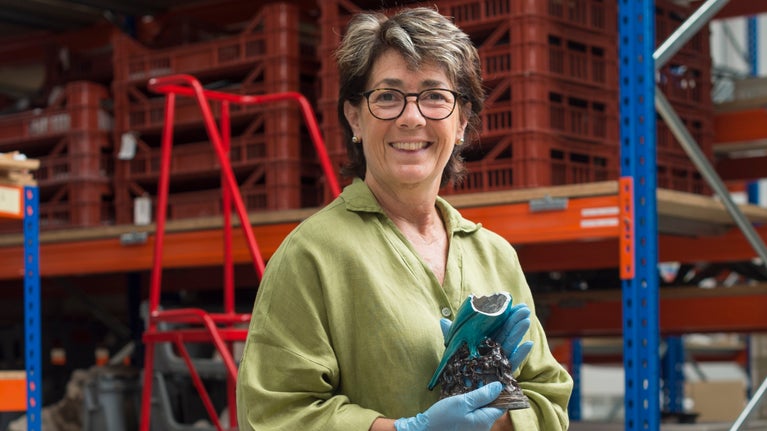
“It’s a Eureka moment when you find pieces that go together. It’s just brilliant.
“We were faced with hundreds of trays of ceramic fragments, mainly in tones of grey where the glaze had been destroyed by the intense heat of the fire and often misshapen by other materials being fused onto them. It was a bit like 1000 jigsaw puzzles all mixed up together.
“We gathered fragments that resembled familiar shapes such as body parts, bases to ornaments, and surface textures such as raised decoration.
“Using inventory photographs, we started working through these groups, looking more closely at each fragment trying match it related to a picture. For me, the handling of these fragments was a journey, feeling the different thicknesses, textures, and becoming more aware and sensitive to the makeup of the ceramic that defined its origin.
“Successfully matched fragments were given a number. As more fragments relating to the same object were collated in a single tray, we began to see if the pieces would fit together.
“When pieces came together it was total euphoria! Moments like this were incredibly satisfying.
“The curators assessed the objects’ significance from both an historical, creative, social and collection point of view. This informed the selection of objects to be sent in trays in their fragmented state to the conservation workshop, which is where I’m also volunteering so I can see this journey continuing.
“I get tremendous satisfaction from putting something back together, giving it new life. It’s not as it was, it could never be as it was. But we can help to reinstate elements that are intrinsic to Clandon’s history. It’s very satisfying contributing with such positive visual results.”
Sara King, a Collections Assistant Volunteer helping the curatorial team caring for Clandon’s ceramics. With a background in art history and conservation, she spent over two years painstakingly identifying and piecing together ceramic fragments damaged in the fire.
Meet Hannah, sharing a community partnership between the school and Clandon

“It’s definitely a partnership. Clandon and the School have a really unique and special relationship.
“We play a vital role in the community. We’re a big family. More so than any school I’ve ever worked at. And we invite everyone in, we’re an incredibly inclusive school. We provide support for families. We don’t want people to get lost. Every child is so unique and so special, and we really celebrate that. When people visit Clandon School, they fall in love with it.
“Not every school in the country has access to a National Trust property. We’re practically next door so when the fire happened lots of the artefacts were stored in the Ark classroom and school hall. Many of the children weren’t born when the fire happened. We recently had a workshop where they saw pictures of all the artefacts.
“We hold our PE lessons in the garden because we don’t have a school field. Most of our children don’t have access to green space, so the fact they get a chance to really run around and explore is so important. And the workshop to design the pattern on the chimney pots was so special. The Year 5 and 6 children got to design a small image that represents Clandon for them. Some did water droplets. And some did leaves because we’re surrounded by trees. It’s really special that their work will be on the roof for years to come.
“We all want to keep the partnership going when Clandon opens. We know access will be slightly different. We’d love to be involved in the community at Clandon, taking part in events and workshops. It's really important that we maintain our relationship because the children need to understand it’s significance."
Hannah Dawe, Head of School and Y5 and Y6 teacher at Clandon C of E School. A small, family school in West Clandon all about nurture and nature and letting children learn through play.
Meet Kiki, curating and testing creative commissions
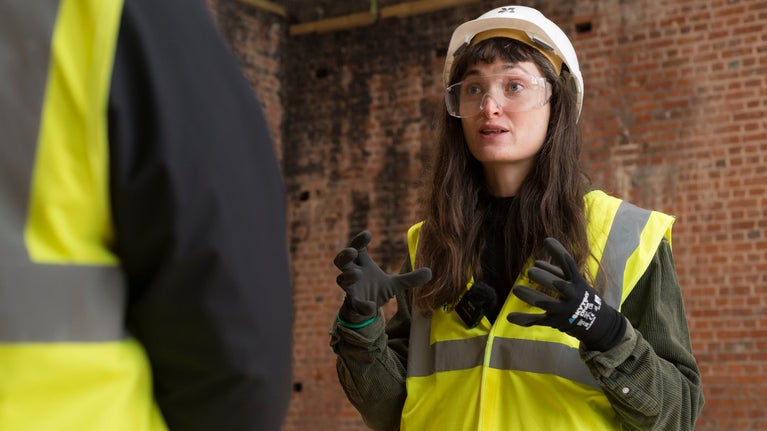
“That’s the beauty of creativity. So many people don’t think it’s for them, but what you can take away is so broad. What you’re feeling. As a dyslexic, the ability to express yourself in different ways is incredible.
“We want our creative commissions to champion social practice. Inviting people to take a creative journey, to look into different subjects or stories in ways that they feel comfortable with. It’s the process of creating artwork that’s important, making sure that people are heard. That they feel valued. We’re opening up Clandon’s doors to people, and they should feel it’s a space for them and that it’s useful for them. Exhibitions and creative commissions are a fantastic way of doing that.
“There’ll be a golden thread of the different parts that make up Clandon, the parts people have told us they’re interested in. We’re testing pilot projects all the time and feeding what people say is really resonating with them back into our programming designs for when Clandon re-opens. The Lounge is a great example of social practice. The artist Harold Offeh asked different groups lots of open-ended questions about home and got them to sketch their thoughts. From that, he created a contemporary mini lounge installation. An amazing, diverse, rich sense of story for those different people.
“To have the opportunity to talk to people about Clandon, to find out what they find really fascinating, and to marry that to art is a real privilege.”
Kiki Claxton, the Experiences and Partnership Curator on the Clandon Park Project, heads up the team who are designing the visitor experience and working with cultural partners to make sure there are a multitude of different voices and people coming together when Clandon reopens.
Meet James, contributing to artwork inspired by Clandon
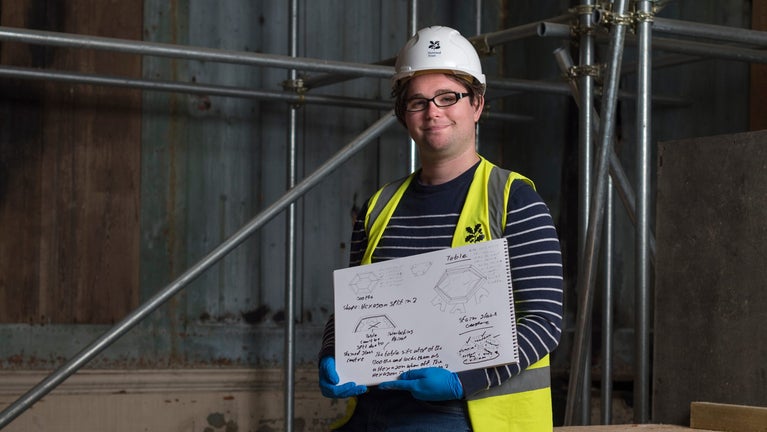
“I definitely learned a lot from Harold. It’s released the artist in me.
“I was eager to take part in the workshop. It was an opportunity to show my more creative side an also to show different concepts from an autistic mindset, which can be a bit difficult to navigate at times. I let the objects we were shown speak to me. There’s always a story to tell or a concept which is sort of buried within and waiting to take shape.
“The first time I met Harold there was obviously first-time nerves. But as we got going, I was at it in seconds. The first thing we had to do was drawing that show certain emotions such as shyness, love, tenacity. Then we worked on chair design concepts and numerous wallpaper designs.
“My design resembles a heart in 3D form that looks like it's spinning. The inspiration for this one, came actually from a historic chair design from Clandon involving heart shapes. This is a sci-fi bubble chair on a metallic frame with an atomic-style element in 3D form right above the wheels. This eyes design was made into a stamp and also featured on the wallpaper in two different forms. One where we see the tears flowing down and one in reverse.
“I didn’t see my designs until the exhibition. I was actually very shocked. I didn’t expect Harold to be caught by my design concepts. This experience has changed my outlook in the art field. I was always in doubt and quite self-judgmental. I have more confidence.”
James Alex Naylor, a young person from the Amber Foundation who support young people facing complex problems towards better, brighter, and healthier futures. James took part in a workshop hosted by the artist Harold Offeh as part of his site-specific installation that reimagined The Lounge – an inviting room at the heart of a home – with Clandon as one of the inspirations.
Meet Callum, assessing the Speakers' Parlour wall panelling
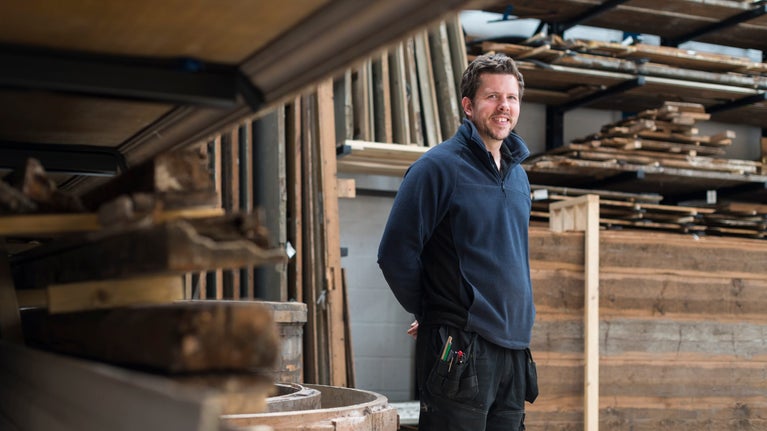
“Everything has a story, whether it’s a piece of timber or something made from timber. As a conserver, you’re part of that process, that story. I look at every piece of wood on its own merit, as a living thing rather than as a material that comes in on a lorry.
“One of the most interesting parts of working in conservation is investigation. The wall panelling from the Speakers’ Parlour had spent time in arduous conditions during the fire and while the salvage was carried out. We laid out the panelling at the collection store looking at a whole elevation at a time so we could make sense of the jigsaw puzzle of components that had been separated. And to make sure there wasn’t anything missing.
“We assessed each piece, recording its condition and giving it a condition score, assessing how you would go about repairing it. We saw a lot of cupping where the wide boards had soaked up water like a sponge and expanded, then dried out unevenly and without being restrained. Timber expands and contracts proportionately more along the growth rings, than from the centre out. With these flatsawn boards, the growth rings are more parallel with one face resulting in uneven shrinkage and cupping.
“Next step is to get some testing underway to get a better understanding of how to repair and correct the cupping to allow people to price accordingly when the work goes out to tender.
“I like knowing I’ve been able to contribute to the story of the Speakers’ Parlour panelling.”
Callum McCaffrey, conservation joiner working with the Trust’s curatorial team to assess the Speakers’ Parlour wall panelling ahead of its restoration.
Meet Sophie, planning the return of the collection
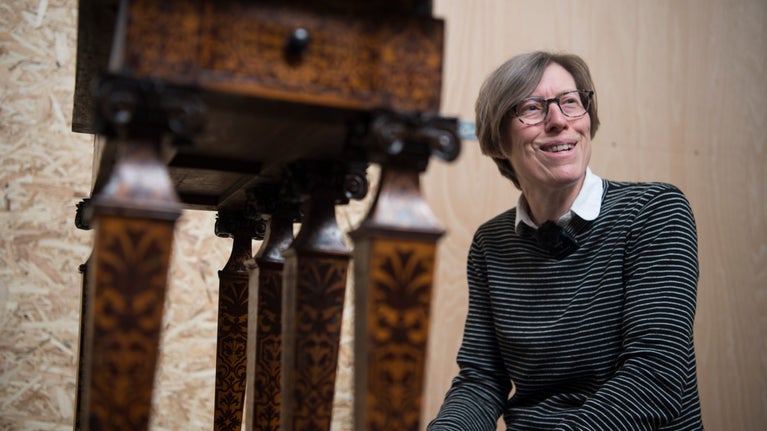
“We have fantastic objects in the Clandon collection which we’re looking forward to displaying in the re-made house. From beautiful pieces of elite furniture like this card table to incredible porcelain and portraits by artists like William Hogarth and Sir Godfry Kneller.
“Fortunately, this marquetry card table was one of the objects from Hannah Gubbay’s collection saved on the day of the fire. It was probably made in about 1690/1700 by Gerrit Jensen, a Dutch furniture maker who moved to England in the late 1660s and specialised in fashionable furniture.
“It’s an excellent example of an early card table. Every surface is covered with swirling leaves and scrolls in delicate marquetry cut from thin veneers of rare American purple wood and fruit woods which would originally have been very brightly coloured. It would have been folded at the side of a room and its marquetry admired, until its wealthy owner wanted to play cards after dinner.
“Playing cards, especially for money, became popular at Court after Charles II came to the throne in 1660 and it quickly became embedded in royal and aristocratic circles. It’s a way of socialising in the home. People lost a lot of money. And let’s not forget, that while they’re sitting playing cards there would have been a battery of people looking after them, bringing wine and food, stoking and fuelling the fire and emptying chamber pots. So, this table also tells us about social history.
“It’s a privilege working as part of the team planning the conservation and re-display of such a wonderful collection.”
Sophie Chessum, the Senior Curator on the Clandon Park Project, heads up the Clandon curatorial team, who are working closely with Trust and external conservators to care for the collection and plan for its return and redisplay when Clandon reopens.
Meet Cary, restoring decorative stone swags
“The stone at Clandon is very different. The fire has changed its characteristics. The Bath stone is incredibly brittle, and the face of the stone is peeling away in places. It sounds hollow when we tap along the stone.
“The first step in conserving the swag was to work out how to get it off the building. Each section was fixed straight onto the building with 300mm long iron cramps into the brickwork. The fire damaged the window arch underneath the swag, so it had dropped and cracked. I removed a lot of cement from historic repairs and removed the bricks around the cramp so I could take the swag off, document and photograph it.
“On the bench, I put all the pieces back together to see what was missing and what could be saved. I pinned all the pieces back together with stainless steel and applied mortar to the repairs. Then cleaned the stone in a way that leaves all the wear. We didn't want it to make it look new, we wanted to make it look like it hadn’t come off the wall. I carved a new piece of stone with the same detail as the missing area, then toned it down with natural pigment to make sure it flowed with the adjoining section.
“Once it was restored and put back together, I created a template of the swag and set out square grid lines. I used that template to mark all the areas with deep pins. With the template on the wall, I know the locations of all the pins in swag before I even lift it up and can drill the holes for the cramps. I’ve got the exact location where the stone goes. There's nowhere to put a level on a swag.”
Cary Wadey, a conservation carpenter and heritage stonemason working on the Essential Works phase of the Clandon Project. Alongside managing the bricklayers and stonemasons on site, Cary has been conserving and restoring masonry, including the decorative stone swags above the windows.
Meet Rosie, conserving the Marble Hall's plaster columns
“It is incredible the columns are still standing. They’re very fragile. They’re survivors.
“What’s really interesting is that they’re all hollow. They were intended to look like they were solid marble, but in fact they’re hollow plaster. They’re made from a wooden lath structure with plaster built up on top of that. You can see there is charring of the timber from fire damage at the top, and the delicate elements on the capitals have been damaged by debris falling. But what we're discovering by looking down into the column is that the wooden structure is relatively unharmed inside some of them.
“We need to build an exoskeleton around them, a support structure from the outside to make sure that while we’re working to conserve them any pressure from the inside isn't going to burst through. Then our plaster conservators will start at the top and carefully clean down inside with a tool they’ve made – like a claw grabber – and a vacuum cleaner to remove debris. Once the inside is clean, a specialist scanning company will drop a rotating scanner into the column to get a better picture of its internal integrity. Once we have that, the engineers and the plaster conservators will design a stabilising methodology and structure.
“Everything takes lots of thinking and lots of collaborative conversations to work out what the answer is and that's why working in a multidisciplinary way is so important. We need to have the expertise from all the different consultants thinking about the best approach. They’re really knotty problems. It’s fantastic working with such a specialist team on a problem and when you reach a solution together, it's really, really satisfying.
“I find Clandon endlessly interesting. From archaeology to dendrochronology, understanding how the fire impacted the fabric and structure, and the geology of the ground beneath us, there’s such a variety. As a curious person who’s passionate about looking after buildings as beautiful as this, it's such a privilege to work here.”
Rosie Partington, a project manager working with the construction team on the Clandon project. Working with a multidisciplinary team of experts, Rosie is project managing the work to consolidate and conserve the plasterwork in the house, including the columns in the Marble Hall.
Meet Benny, conserving Clandon's chimneys
"Standing in the Marble Hall during my first site visit after the 2015 fire, I was overwhelmed by a sense of place. The house reveals layers of story as an architectural palimpsest, where earlier uses and historic fabrics coexist with later additions, including the scars of the fire.
“I love working on the Clandon Project. I’m learning all the time and from experts at the top of their field. I’ve worked on conservation projects before, but nothing as complex as Clandon.
“The Design Team ran Pilot Works to test and learn the best conservation approach for the chimney stacks. Chimney 4 was weather worn with fire damage from years of domestic fires. It was also leaning because of destabilisation in the 2015 fire. The chimney stack was partially dismantled for closer investigation. It was then rebuilt using new and salvaged bricks, along with new stone and lime mortar. This gave us a good understanding of the existing chimney construction and informed our proposal to retain the remaining 13 chimneys, supporting each one with external Corten steel straps to resist wind loading.
“Together with the Design Team, I produced the elevation drawings with detailed information about each chimney element and the repair work requirements so the craftspeople can clearly understand what’s needed for each area. We’re working to the Trust’s conservation principle to ‘conserve first before replacement’ so each brick is carefully recorded and labelled before repair work is carried out.”
“I’m working with the Trust’s curator, conservation specialists, as well as the UK’s leading heritage bricklayers, stonemasons, timber specialists, and structural engineers with conservation expertise. It’s a really collaborative relationship. We have a good discussion with everyone sharing their expertise so we can reach a decision together.”
Benny Chung, an architect working on the Essential Works part of the Clandon Project. Alongside a fellow architect, Benny has been creating the designs for the works to conserve and stabilise the surviving brick and stone structure, including the chimney stacks.
Meet Alastair, mapping historic graffiti
“We’re working with a wide definition of graffiti. I expected it to include names, and we’re also looking for makers marks and marks made during construction. Where a staircase has burned away, you can now see the line put on the wall as a guide to follow by the carpenter installing it.
“We could see the fire at Clandon from our window that night. I came on a tour as soon as I could and was fascinated by what I could see of the surviving building and what it showed about how the house was constructed. When I retired, I was looking for something to do and thought I could do tours of the house. I gave tours of buildings in my job so I knew I could do them. When the tours stopped, I volunteered to help with research so I could still be involved with Clandon.
“I’ve got detailed plans of all the interior elevations of the house marked with gridlines, and orthographic images for each area which I’m examining for signs of graffiti. I’m recording a detailed description of what I’m seeing in each grid on a spreadsheet. It’s meticulous.
“Sometimes it’s hard to tell if it’s graffiti or a natural feature in a brick. There’s different dates and styles of writing from different historic periods, and a concentration of graffiti in the basement and on the roof.
“The graffiti reflects the people who wanted to leave their mark, that they were here at Clandon, whether building the house or living there afterwards. It’s a human response to want to leave your mark. I found ‘John Porte’ on the photograph of this chimney but, looking at it now, it could actually be ‘John Porter’”
Alastair Gourlay, a research volunteer helping the curatorial team map the instances of historic graffiti in the building. Along with a fellow volunteer, Alastair has been examining ortho-photographs of the interiors and cross referencing to grid referenced elevations, meticulously mapping where people from Clandon’s past have made their mark.
Sharing stories
See more from the stories of how Clandon is being brought back to life.
You might be interested in
The project at Clandon Park
Take a look at our timeline to find out what the team have been working on.
Our vision: Celebrating the many hands who made Clandon
Learn about our vision to carefully conserve and creatively curate Clandon Park – celebrating the beauty of the surviving building and the many stories of the people who made and crafted the house.
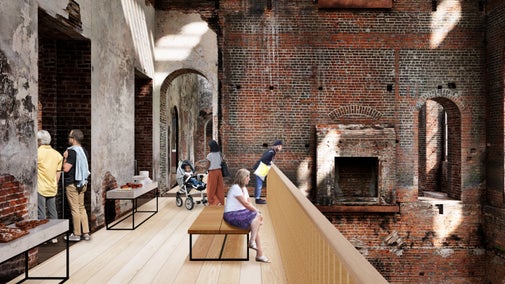
Celebrating the talent of plaster sculptors
Discover what we've learned about the decorative plasterwork at Clandon Park, who made it and what we're starting to find out about how they did it.
